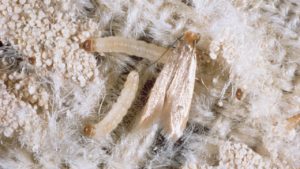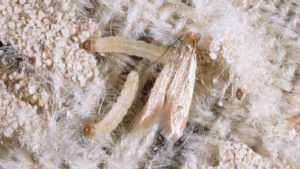Clothes moths are well-known house pests, having a global presence. They usually feed on wool and woolen stuff but they may infest a wide range of natural fibers such as hair, fur, felt, silk, feathers, etc. Their infestation often goes undetected, as they mostly infest stored clothes and those areas of carpets and floor coverings that do not receive much sunlight and traffic.
What are Clothes Moths?
Clothes moths are a type of fungus moths that feed on wool and other natural fibers. The common species are webbing clothes moths and casemaking clothes moths.
- The webbing moths measure 7-8 mm in length. Their wings are golden buff colored, having long hairs at the margins. The head has a cluster of reddish hair. The larvae of webbing clothes moths are 12-13 mm long with a creamy-white body and a brown head. The larvae
has one eye (ocellus) on each side of the head. They are called webbing moths because they spin feeding tunnels or patches of webbing as they move on the surface of the fabric.
- Casemaking moths are almost same in shape and size as webbing moths except that they don’t have reddish hair on their head. The wings of the young adults have dark spots, which fade away as they age. The larvae of casemaking moths have a pair of eyes. They are called casemaking moths because they enclose themselves in a portable case made of the same fiber that they are eating or may have eaten.
Clothes Moth Life Cycle
- Like all other moths, clothes moth also undergo four distinct stages; egg, larva, pupa, and adult stage. A female moth can lay around 100-400 eggs at a time. The eggs take about 4 to 10 days to hatch, depending on temperature and humidity.
- After hatching, the larvae come out and start feeding on the available resources such as woolen clothes, silk, carpets, etc. Larval stage is the most destruction stage of a clothes moth’s life. The moths may take up to 30 months to molt into pupal stage, until they find their favorable conditions to pupate. They will happily persist through winter, spring, and summer, eating your clothing and waiting for the right conditions to turn into adult moth.
- Once they get their favorable condition, they will enter into the pupation stage in which they will spin a cocoon to transform into an adult. This process can take up to 10 days.
- The adult clothes moths will mate and lay eggs within a few days. The female moths die within two weeks of depositing eggs (3-16 days), whereas the males may survive for almost a month.
Frequented Areas of Clothes Moths (Where Do Clothes Moths Come From?)
The natural range of cloths moths is western Eurasia. However, they have a global presence. They have a great ability to survive under extreme conditions, especially when they are in their larval stage. This is the reason why they can be found across the globe, wherever they
get favorable climate and food.
Clothes Moth Identification & Special Characteristics
- Clothes moths are afraid of light. So, they prefer closets, basements, and other dark and undisturbed places.
- They do have wings but they prefer not to fly, even when they are disturbed. If you see a moth flying around your home, it is probably a grain moth and not clothes moth.
- Adult clothes moths do not cause any damage to the fabric. It is the larva that causes all the damage by feeding on fabrics. The larvae can be found under the hidden parts of the clothing such as cuffs and collars.
Damage Caused By Clothes Moth
This pest is notorious for feeding on natural fibers, especially wool and silk. They have the ability to digest keratin protein, which is the reason why they prefer wool, silk, feathers, and fur, but they may infest cotton and other natural and synthetic fibers if they are heavily soiled with human sweat, body oil, food particles or dirt. Damage may range from irregular surface created due to the feeding of the moths to small holes eaten through the fabric.
The commonly infested items include woolen sweaters, carpets, coats, blankets, pillows, comforters, upholstered furniture, toys, and any other thing that is made of natural fiber. Clothes moths do not infest clothing and blankets that are used regularly. Instead, they prefer to attack things that are stored at cool, undisturbed places for a long time.
Often, good housekeeping practices are enough to keep these unwanted fabric-eating pests away. But, if you are having trouble eliminating them completely, please contact your nearby pest control company for help.



No Comments